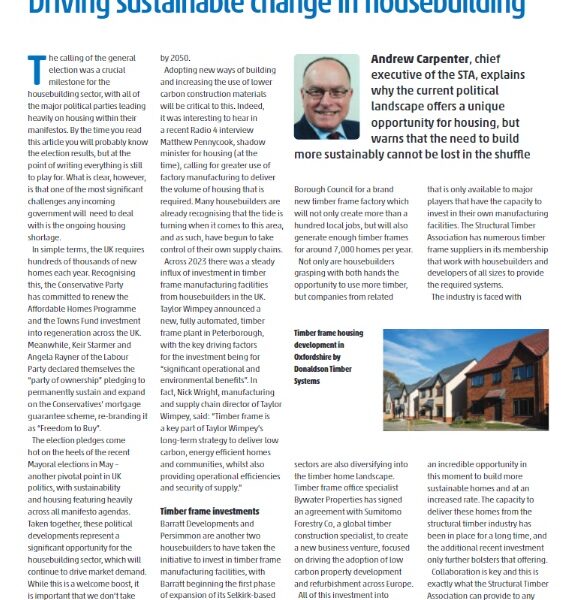Driving sustainable change in housing
03/07/2024

Andrew Carpenter, Chief Executive of the STA, explains why the current political landscape offers a unique opportunity for housing, but warns that the need to build more sustainably cannot be lost in the shuffle.
The calling of the general election was a crucial milestone for the housebuilding sector, with all of the major political parties leading heavily on housing within their manifestos. By the time this article is published the election results will be known, but at the point of writing everything is still to play for. What is clear, however, is that one of the most significant challenges any incoming Government will need to deal with is the ongoing housing shortage.
In simple terms, the UK requires somewhere in the region of hundreds of thousands of new homes each year. Recognising this, the Conservative pary has commited to renew the Affordable Homes Programme and the Towns Fund investment into regeneration across the UK. Meanwhile, Keir Starmer and Angela Raynor of the Labour party declared themselves the ‘party of ownership’ pledging to permantly sustain and expand on the Conservatives’ mortgage gurantee scheme, rebranding it as ‘Freedom to Buy’.
The election pledges come hot on the heels of the recent Mayoral elections in May – another pivotal point in UK politics, with sustainability and housing featuring heavily across all manifesto agendas. Taken together, these political developments represent a significant opportunitiy for the housebuilding sector, which will continue to drive market demand. While this is a welcome boost, it’s important that we don’t take our eye off the ball in terms of sustainability. Yes, we must build more homes but we must do so in a way that supports the UK’s commitment achieving Net Zero by 2050.
Adopting new ways of building and increasing the use of lower carbon construction materials will be critical to this. Indeed, it was interesting to hear in a recent Radio 4 interview Matthew Pennycook, Shadow Minister for Housing (at the time) calling for greater use of factory manufacturing to deliver the volume of housing that is required. Many housebuilders are already recognising that the tide is turning when it comes to this area, and as such, have begun to take control of their own supply chains.
Across 2023 there was a steady influx of investment in timber frame manufacturing facilities from housebuilders in the UK. Taylor Wimpey announced a new, fully automated, timber frame plant in Peterborough, with the key driving factors for the investment being for “significant operational and environmental benefits”. In fact, Nick Wright, manufacturing and supply chain director of Taylor Wimpey, said: “Timber frame is a key part of Taylor Wimpey’s long-term strategy to deliver low carbon, energy-efficient homes and communities, whilst also providing operational efficiencies and security of supply.”
Barratt Developments and Persimmon are another two housebuilders to have taken the initiative to invest in timber frame manufacturing facilities, with Barratt beginning the first phase of expansion of their Selkirk-based Oregon site early in 2024; part of a £24million investment.Additionally, Persimmon’s sister brand Space4 has also received approval from Charnwood Borough Council for a brand new timber frame factorywhich will not only create over a hundred local jobs, but will also generate enough timber frames for around 7,000 homes per year.
Not only are housebuilders grasping the opportunity to use more timber with both hands, but companies from related sectors are also diversifying into the timber home landscape. Timber frame office specialists, Bywater Properties, has signed an agreement with Sumitomo Forestry Co, a global timber construction specialist, to create a new business venture, focused on driving the adoption of low carbon property development and refurbishment across Europe.
All of this investment into timber frame certainly seems to be shaping a path for the future of the housebuilding sector. However, it’s important to point out that this is not a direction that is only available to major players that have the capacity to invest in their own manufacturing facilities. The Structural Timber Association has numerous timber frame suppliers in its membership that work with housebuilders and developers of all sizes to provide the required systems.
The industry is faced with an incredibly opportunity in this moment to build more sustainable homes and at an increased rate. The capacity to deliver these homes from the structural timber industry has been in place for a long time, and the additional recent investment only further bolsters that offering. Collaboration is key and this is exactly what the Structural Timber Association can provide to any housebuilder looking to extend its offering to timber frame.
Read the full article here on page 39: https://edition.pagesuite-professional.co.uk/html5/reader/production/default.aspx?pubname=&edid=f017d5d6-9037-4866-9146-5727cbe308f1